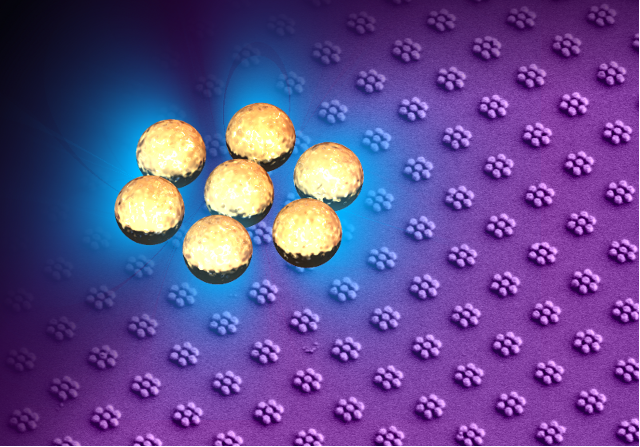
Gold heptamer structures show strong Fano resonances. The gold nanoparticles are only about 150 nanometers in diameter. (c) Sven Hein, Na Liu, Harald Giessen, University of Stuttgart, Germany.
Photonics is all about light. Processing of light for applications ranging from holograms and displays to optical telecommunications. Thanks to a better theoretical understanding and to advances in fabrication technology, photonic devices and gadgets have become increasingly versatile and powerful.
But photonics also has a dark side. In many light-processing devices and structures there are dark modes — oscillations of the light wave that while not forbidden cannot be directly excited by a given experimental configuration. In a violin for example, the strings are best sounded by drawing the bow perpendicular to their length.
However, the dark modes in photonic devices are not lost to applications. In the past months, researchers have developed new approaches that can make use of the dark modes by using interference effects with the allowed, bright modes. The resonances created by this interference are called Fano resonances, after Ugo Fano who first described them in 1961.
“Fano resonances are cool because they are the manifestations of dark modes that cannot be excited directly. In any system there are only a few bright modes but an infinite number of dark modes. The Fano resonance is the interference between a bright mode and one of the dark modes,” explains Peter Nordlander, a physicist from Rice University in Houston, Texas.
Fano resonances are very sharp, with a spectral shape that is much narrower than what can be achieved with comparable regular oscillators and their Lorentzian lineshape. This advantage makes them attractive for sensing applications. Because the spectra of Fano resonances are so narrow, the tiniest changes to the local environment of the resonator structures lead to noticeable shifts of the resonance wavelength. Even the presence of a single molecule could be detected.
[…]
Continue reading...
One of the fundamental concepts of quantum mechanics is that objects can be described as waves, whether they are electrons, atoms, light, anything really, even your cat (or that of Erwin Schrödinger). And of course, if the equations that describe their wavefunctions are identical, objects will behave in the same way. Even if they are fundamentally different physical entities.
Two papers published this week highlight just how far this analogy can go. In one study a gas of ultracold atoms behaves like electrons in a crystal, whereas in the other study the ultracold atoms show quantum effects known from laser physics. Atoms behaving like electrons as well as light.
[…]
Continue reading...
Go to any condensed-matter physics meeting, and topological insulators are prominent on the agenda, and talks on the topic attract large audiences. For good reason. Topological insulators promise nothing less than a revolution in electronics. Even though as their name suggests topological insulators are electrically insulating, they are conducting on their surface. And unlike regular conductors, these surface currents flow without the electrons being thrown off the track by most (albeit not all) scattering effects from impurities. This is one of their key features that ultimately may lead to smaller and faster electronic devices.
Even though first experimental breakthroughs have been achieved since 2006 in two-dimensional (thin films) of HgTe with similar properties, the tell-tale surface currents haven’t been observed in three-dimensional topological insulators such as the widely studied Bi2Se3 and Bi2Te3. So far, samples have not reached a sufficient purity and researchers had to make do with indirect characterisation experiments rather than direct measurements of electrical transport. This has now changed. In a study published in today’s issue of Science, Robert Cava, Nai Phuan Ong and colleagues from Princeton University report on the first experiments demonstrating electron conduction on the surface of Bi2Te3.
[…]
Continue reading...



August 24, 2010
3 Comments